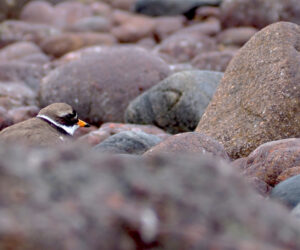A small, robust and boldly marked wader found on open shores, preferring sandy or gravelly habitats. In summer, adults have striking orange legs and feet, and a short black-tipped bill with an orange base. The breast and belly are white, while the upperparts and crown are brown-grey. Ringed plovers have a distinctive white collar with a black breast band below. This breast band is usually paler brown in females. In winter the colour of their plumage and their orange legs and bill appear duller. They have a distinctive central white wing bar in flight.
Behaviour
Like other plovers, the ringed plover forages for invertebrates and crustaceans in a particular way: standing and watching, running forward, pecking, and standing still again. The ringed plover tempts underground prey to the surface by ‘foot-trembling’ i.e., tapping its feet on the ground to mimic raindrops. It forages by day and night, typically in small groups of up to 50 birds, and occasionally in much larger flocks.
They roost together close to their feeding areas, usually just above the high tide line. The ringed plover characteristically flies fast and low over ground or water with steady wingbeats and short glides.
The simple nests (a scrape on open ground) provide little protection for eggs and chicks which are particularly vulnerable to predators, such as hedgehog, brown rats and the American Mink. The failure rate on many Scottish sites is high and second broods are rare.
Size
- Length 18-20cm
- Wingspan 35-57cm
- Weight: 55-75g
- Average Lifespan: 5 years
Status
Classified in the UK as Red under the Birds of Conservation Concern 4: the Red List for Birds (2015). Protected by The Wildlife and Countryside Act 1981.
Distribution
Found around the coastline of Scotland as a widespread breeding species. Found locally inland, along rivers, estuaries and tidal flats, reservoirs and arable fields. Breeding populations tend to move only short distances in winter. The highest numbers of ringed plovers occur in May, when resident populations are joined by birds on the spring passage north.
When to see
All year round.
Facts
- Ringed plovers have suffered a major decline in numbers and dropped from the Amber status of conservation (1996) to the Red List (2015). Populations on the Outer Hebrides and other Western Isles have suffered from the colonisation of hedgehogs and mink since the early 1970s.
- The alarm call of ringed plovers is a soft, but anxious ‘poo-ee’ with an upward inflection. During the breeding season, the aerial display is accompanied by a repeated ‘tee-leea, tee-leea…’ or ‘leea-leea…’

